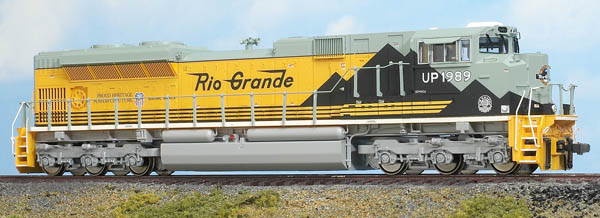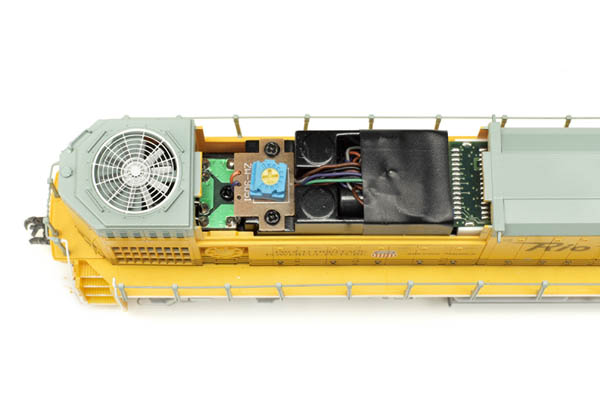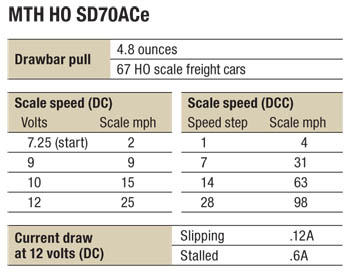Prototype. In 2005 General Motors Electro-Motive Division began delivering SD70ACe diesel-electric locomotives to its North American customers. The SD70ACe was designed to meet stricter environmental protection emissions standards that went into effect that same year. The AC in the locomotive’s model name denotes its alternating-current traction motors. The “e” stands for enhanced, referring to improvements made over prior SD70 models.
The SD70ACe has a 4,300-hp 16-710G3C-2 diesel engine that delivers 10 percent more horsepower than previous 16-cylinder 710 engines with 50 percent less emissions. You’ll find an article complete with prototype drawings of an SD70ACe in the November 2004 Model Railroader. The dimensions and placement of details on the MTH model match those drawings. However, the operating front and rear couplers are both a scale foot too long.
The Union Pacific has the largest fleet of SD70ACes, with 365 locomotives. In 2005 the railroad commissioned the Wisconsin & Southern RR paint shop in Horicon, Wis., to paint six of the SD70ACes in unique “heritage” paint schemes. These locomotives paid tribute to railroads that had been taken over by the UP. Our review sample is a model of UP no. 1989, which was decorated to honor the Denver & Rio Grande Western Ry., absorbed into the UP in 1996.
For the most part the MTH model’s paint scheme matches prototype photos. All lettering is straight and opaque. The stripes that run over the black mountain graphics on the side of the cab appear to be a lighter shade of yellow than on the prototype. Another deviation is that stripes on the back of the AC converter housing located just behind the fireman’s side of the cab don’t align with those on the hood.
The plastic body shell has crisply molded detail and many separately applied parts, including the global-positioning-satellite dome on the cab roof, the correct five-chime horn, and scale profile handrails. The see-through grill detail on the sides of the radiator and hood is well done. I especially liked the separately applied radiator fans with see-through grills on top of the hood.
New couplers and sound. The most innovative feature of the MTH SD70ACe is that you can open the model’s front and rear couplers using a DCC or DCS throttle. On DCC, function 7 opens the front coupler and function 8 the rear. A DCS throttle or Digital Commander controller has front and rear coupler buttons. I tested the model’s couplers on both a DCC and a DCS system, and they worked flawlessly with the appropriate sound effects.
Because of the spring tension required for the couplers to open remotely, the model must be moving at least 22 scale mph for the couplers to engage the coupler of an adjacent freight car and close their knuckles. On a real railroad, backing a locomotive into a train at that speed would probably cause an engineer some unwanted attention from the trainmaster.
The sound quality of the model is excellent. Two downward-facing speakers are mounted in the fuel tank. The diesel engine sounds are especially well done. You can also manually adjust the engine rpm levels independently of the locomotive’s speed.
For model railroaders with DC layouts, sound effects are limited to automatic sounds such as the diesel engine starting up and idling. The rpms increase when the throttle is advanced, and squealing brakes are heard when the throttle is decreased rapidly.
The MTH model supports only programming on the main. In DCC there are 10 programmable configuration variables (CVs), including the address and acceleration and deceleration momentum. You can also program CV29, which is useful if you want to have a trailing MTH SD70ACe in a multiple-unit consist facing backward.
Out of the box the MTH SD70ACe doesn’t support CV19, so you can’t advance consist the locomotive. Simple consisting is also problematic because you can’t disable individual functions, such as the lead unit’s rear coupler or the bell and horn of a trailing unit.
An MTH representative informed me that the company will soon be offering a free user-installed upgrade for the SD70ACe. This will allow you to set speed tables, remap functions, and advance consist the locomotives using DCC. These upgraded electronics will also be included in future MTH HO locomotives.
The model ran well in both DCC and DCS modes. Using a DCS Digital Commander, I had the model moving in speed step 1 at 1 scale mph. In DCC the SD70ACe has smoother slow-speed performance when using 128 speed steps instead of 28 and started moving in speed step 1 at 2 scale mph.
The MTH SD70ACe in HO scale offers excellent performance and a wide array of realistic sound effects. The upcoming free electronics upgrade will make it even better. The model’s remotely opening couplers highlight the potential of command control for making locomotive models even more fun to operate.
Price: $249.95
Manufacturer
MTH Electric Trains
7020 Columbia Gateway Dr.
Columbia, MD 21046-1532
www.mthhotrains.com
Road names: (Union Pacific heritage schemes) Denver & Rio Grande Western, Chicago & North Western, Kansas City Southern, Missouri-Kansas-Texas, Missouri Pacific, Montana Rail Link, Southern Pacific, Western Pacific. Union Pacific American flag scheme (four road numbers) and George Bush no. 4141. Other road names: BNSF, CSX, and EMD demonstrator
Era: 2005 to present
Features
All-wheel drive and electrical pickup
Automatically switches between DC, Digital Command Control, and MTH Digital Command System modes
Constant brightness headlights
Five-pole skew-wound motor with brass flywheel
Lighted cab interior and number boards
Metal RP-25 contour wheels in gauge
Minimum radius: 18″
MTH Proto-Sound 3.0 system operates on DC, DCC, and DCS layouts
Two remote-control operating couplers mounted at correct height
Weight: 1 pound 9 ounces
















